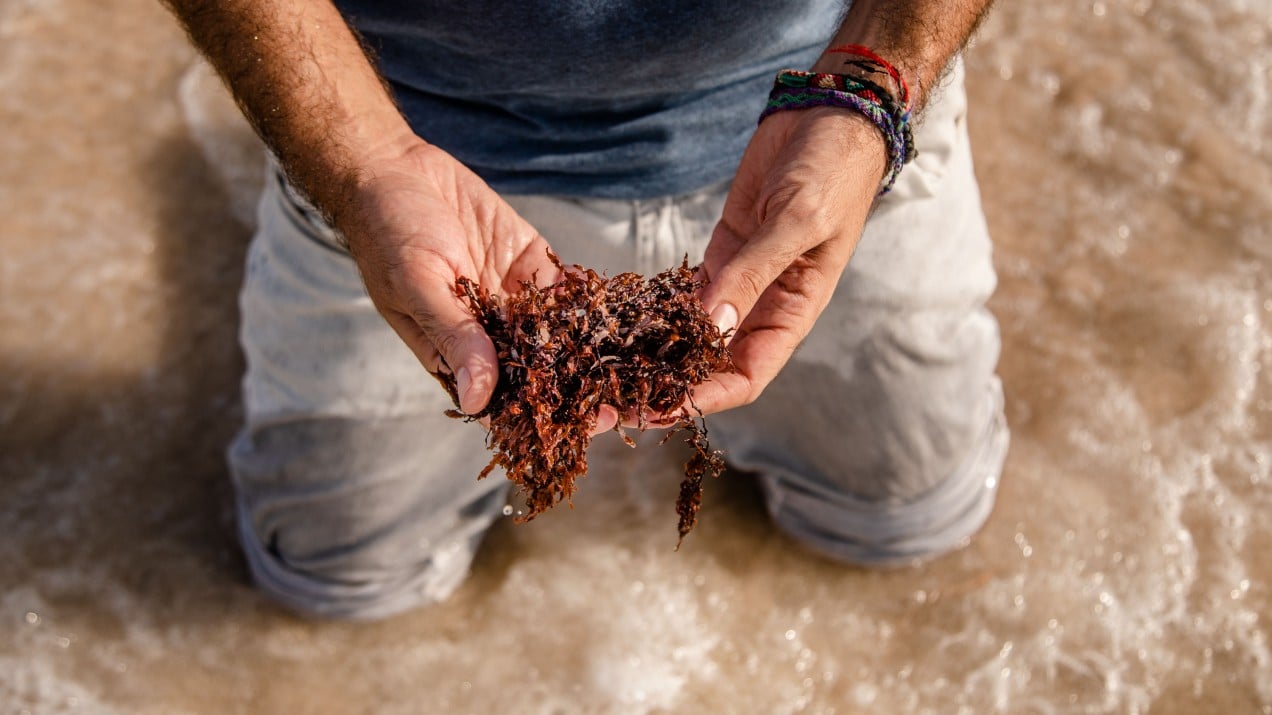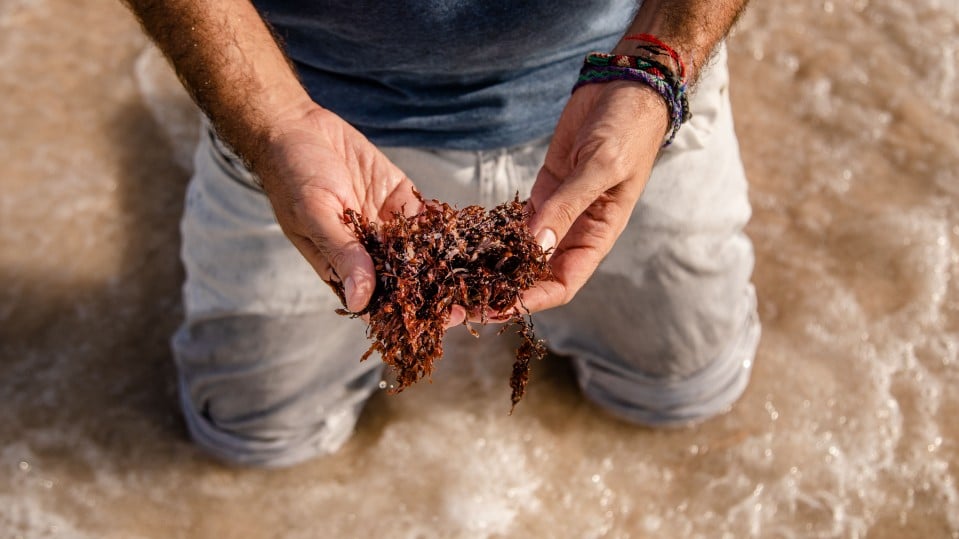

Climate Change / Clean Energy
Why seaweed is strangling Mexican tourism, and how science could help
Sargassum is infesting Mexico’s coastline. Researchers are scrambling to stop an ecological crisis, and maybe even make something good of it.

The posh seaside resorts of Puerto Morelos are still in view when the captain playfully sounds the horn to alert the crew to the target ahead—a huge, golden-brown stain stretching toward the horizon. Suddenly, instead of the famed cerulean waters of Mexico’s Caribbean coast, we’re surrounded by thick mats of seaweed, a sulfurous tinge in the air.
This is exactly where the crew of a specialized Sargassum collection boat wants to be. The boat belongs to Grupo Dakatso, a consortium of five companies working on new seaweed collection technology. The small catamaran has a specialized conveyor belt positioned at the bow that draws piles of seaweed from the water into large mesh collection bags. All the crew can manage above the roar of the engine are whistles and hand signals as the bags, each holding 300 kilograms (660 pounds), are filled within a minute or two.
Since the spring of 2018, Mexico’s Caribbean coast and the shorelines of 19 other countries in the region have been inundated with unprecedented amounts of Sargassum seaweed. Tourists expecting pristine white beaches have instead been confronted with endless piles of slimy, decaying vegetation. While it’s normal for the brown macroalgae to appear on Caribbean shorelines in smaller amounts, outlier blooms have been increasing in size and regularity over the past 10 years. The one that occurred last year is believed to be the worst ever in the region. Now efforts are mounting not just to contain the ecological crisis but to capitalize on it.
Usually Sargassum arrives in the Caribbean from its namesake sea in the eastern Atlantic. But researchers believe the 2018 influx came from a new source: the equatorial waters between Brazil and West Africa, where pesticide and fertilizer runoff from the Amazon and Congo Rivers fed the algae bloom. This bloom was amplified by climate change, says Brigitta van Tussenbroek, an ecologist at the National Autonomous University of Mexico in Puerto Morelos: rising ocean temperatures help the seaweed proliferate faster. Deforestation in the Amazon rain forest also feeds the bloom—not only does it increase the pesticide and fertilizer runoff, but it is itself a massive contributor to climate change.
“We, us humans, are to blame for the Sargassum problem,” says Dagoberto Ruiz Lavín, general director of Grupo Dakatso, which local hotels and the government had contracted to clear away the seaweed. “The future generations are going to have it much worse if we don’t do anything,” he says. “The Sargassum is not going to stop coming.”
In ordinary conditions, Sargassum is a normal, even healthy, part of the ocean. But in vast quantities, the seaweed brings a litany of harms to coastal ecosystems. Mats of it block much-needed sunlight from coral reefs, causing disease or death. As the seaweed dies and decays, bacteria suck up oxygen in the water while nitrogen, phosphorus, and other nutrients are released in massive quantities. If the seaweed is left to rot on land, as it is on Mexico’s beaches, the same nutrients threaten to leach into groundwater. In the Yucatán Peninsula, where the only source of fresh water is a unique regional network of underground rivers, water contamination is a serious worry. And while seaweed can draw carbon dioxide from the atmosphere, just as trees do, it’s beneficial for the environment only if the seaweed is harvested and processed, and the resulting CO2 is stored away permanently (see "The desperate race to cool the ocean").
Van Tussenbroek says the cumulative effects of Sargassum overgrowth are enough to disrupt the equilibrium of an ecosystem. As one example, Sargassum kills the seagrasses that help keep sand in place, so beaches erode faster. She estimates that after the 2018 crisis, the local ecosystem might be able to reset itself in anywhere from 10 to 50 years, but if there’s another large, unmitigated influx or a major hurricane, changes could be permanent.
To date, Mexico’s official response to the Sargassum crisis has been limited to marine barriers—similar to those used in oil spills—and beach clean-up crews armed with rakes and wheelbarrows. It’s a Sisyphean task: once the beach is clean, the next tide of seaweed is never far behind. José Ángel Durán Désiga, a weary-eyed but surprisingly young municipal bureaucrat, explains the limitations of the government’s response from his office near the beach in Playa del Carmen. As director of the Office of Environment and Climate Change in the municipality of Solidaridad, Durán Désiga is at the forefront of the Sargassum challenge. But under Mexico’s centralized government system, he says, local officials lack the resources or authority to do much about it.
“The coast will continue to exist, but it will be in a different ecosystem,” Durán Désiga says. “It might be without the reefs. There might be more and different kinds of fish. It will be more complicated for tourists to enjoy the water.”
Even if seaweed collection could be vastly scaled up, one big question remains: what to do with it all?
Seaweed is already used widely in cosmetics and food additives. Energy companies like ExxonMobil have invested in research on microalgae—a type of microscopic organism that sometimes causes red and brown tides—with the idea of creating a low-emissions transportation fuel by extracting oil from it. Seaweed, a macroalgae, hasn’t drawn the same kind of attention as a biofuel source, in part because seaweed can be difficult to farm on a mass scale. Seaweed has been tested as a feedstock for biogas via a process called anaerobic digestion, which involves placing it in a tank, letting it decompose, and then capturing the resulting gases, like methane, which can be used for energy. But seaweed is rich in a polymer called lignin that must be broken down in order to create methane. Now, Mexican researchers are searching for ways to get around that problem.
At the Yucatán Center for Scientific Research, a complex of government-funded labs set amid a lush jungle on the outskirts of Mérida, the Yucatán state capital, the smell of Sargassum is in the air. David Valero, a PhD researcher specializing in anaerobic digestion, is part of a team working to design a seaweed-to-biogas process that is more efficient and can handle seaweed directly from the beach or sea with minimal need for processing to remove sand or plastic.
Valero and his colleagues have been working both to speed up the seaweed breakdown process—by pre-treating the Sargassum with a local fungus—and to increase the efficiency of the bioreactor using activated carbon. He says they are close to commercializing their technology, which creates biogas that can be used directly for electricity generation. He estimates that each ton of Sargassum can produce the equivalent of 720 kilowatt-hours of energy or 63,600 liters (16,800 gallons) of natural gas.
One lab over, biologist Francisco Larqué Saavedra has other plans for Sargassum. Long interested in sustainable food production, he’s built a bank of native mushroom species over the past 30 years. In 2018, he started looking for a strain that could grow in seaweed. His team grew mushrooms in plastic bags stuffed with Sargassum that was pasteurized and processed beforehand, yielding about 800 kilograms of edible mushrooms for every metric ton of dried seaweed. Larqué Saavedra hopes to persuade hotel owners to start mushroom farms on-site, to make use of the seaweed piling up at their door and generate both food and jobs.
The region is a long way from achieving his vision. The Association of Hotels of the Riviera Maya reported a 10% decrease in occupancy last year as a result of the seaweed. Tourism accounts for more than 8% of Mexico’s GDP, and Quintana Roo, the Mexican state on the east coast of the Yucatán Peninsula, accounts for 40% of Mexico’s foreign visitors. Hotels and restaurants generate 25% of Quintana Roo’s GDP, and their workers would have a hard time finding jobs in another industry. Fewer tourists means lower government revenue, and thus less money to fund Sargassum removal. The economic upheaval from a loss of tourism would also boost the drug cartels, whose violence has recently been encroaching on the peninsula’s tourist areas.
So by strangling tourism, the seaweed is also cutting off oxygen to anyone who tries to stop its invasion.